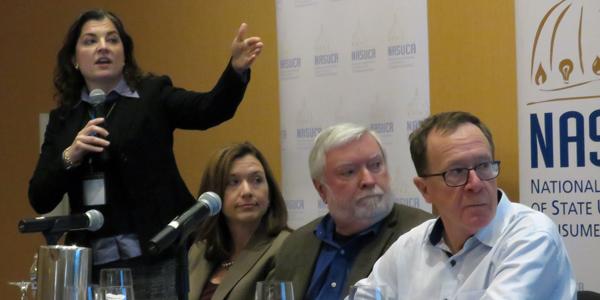By Rich Heidorn Jr.
BALTIMORE — Speaking last week to an audience of consumer advocates, John P. Hughes, CEO of the Electricity Consumers Resource Council (ELCON), led off his critique of RTO stakeholder processes with a blunt assessment: “The main takeaway is it can’t be fixed.”
Other participants who joined Hughes in a panel discussion at the National Association of State Utility Consumer Advocates (NASUCA) annual meeting Wednesday were more optimistic.

Panelists left to right: Simeone, Foster, Hughes and Malcolm | © RTO Insider
Unfortunately, the speakers’ opening presentations at the discussion — cheekily titled “20 Years of RTO Meetings and We’re Still Not Done?” — swallowed up the entire 70-minute session. As a result, Denise Foster, PJM’s vice president of state and member services, never got a chance to respond to the critiques.
Room for Improvement
AARP’s Bill Malcolm, a former MISO manager of state regulatory affairs, opened his presentation by praising RTOs for improving generation dispatch and eliminating rate pancaking.

Malcolm | © RTO Insider
But he said they should be required to follow open meetings laws and enact ethics reforms, including a ban on revolving-door hiring. He also called for tightening cost controls. “RTOs don’t print money,” said Malcolm, AARP’s senior legislative representative for state advocacy and strategy integration. “It’s ratepayer dollars at the end of the day.”
He also said RTOs should add ways to better represent residential ratepayers in stakeholder proceedings, including establishing an RTO-funded organization like the Consumer Advocates of PJM States (CAPS).
“Let’s make a good thing better,” Malcolm said.
Unstable Market Design
Hughes, whose organization represents industrials, said a large manufacturer might have only one or two electricity buyers for national or international operations — making it impossible to monitor the hundreds of RTO stakeholder meetings annually.

Hughes | © RTO Insider
“The market design has never — and may not ever — be stabilized. Therefore, the stakeholder process will forever be the resource hog that it is today,” he said, citing capacity markets as an example.
“It is the wrong solution to the problem, caused by not having shortage pricing or surge pricing. And since the capacity market doesn’t really work, it’s under continual attack for tweaks and fixes that will go on forever unless we come up with a different market design — which I don’t think will happen.”
Hughes said almost all the proposals that go through the stakeholder process are efforts to increase charges to ratepayers. “The current driver of market design changes — which is [the call for] price formation, including the new [Department of Energy Notice of Proposed Rulemaking] — is very low-cost shale gas. There seems to be a conspiracy to deny consumers the benefit of this resource,” he said.
Hughes said ERCOT — which has a board seat reserved for industrial consumers — is the only governance structure his group likes. Industrials’ presence on the board means “you gain respect in the whole food chain,” he said.
PJM Study
Christina Simeone, director of policy and external affairs for the Kleinman Center for Energy Policy at the University of Pennsylvania, spoke about her May 2017 study on PJM’s governance, which asks “Can Reforms Improve Outcomes?”
Among her conclusions: PJM’s stakeholder process is very effective on less contentious issues but is less effective on the most contentious issues that are subjected to sector-weighted votes.

Simeone | © RTO Insider
Because of affiliate voting, the lower committees are subject to a “huge supply-side bias,” she said, citing the now-closed Seasonal Capacity Resources Senior Task Force, where 190 votes were cast by 34 respondents. Just 10 companies can prevent any proposal from passing at the lower level, she said.
But while suppliers can muscle their proposals through the lower committees, she cited a Pennsylvania State University study that found a load-side bias at the upper levels, where End Use Customers and Electric Distributors have formed a tight voting coalition. “What ends up happening is all the proposed solutions are supply-side biased and then they get knocked down by the load-side bias at the higher level. This is a phenomenon I think we’re seeing more and more,” she said.
She said RTO management has an interest in preventing political backlash over price volatility and blackouts, “so the organization may seek to prevent those things, perhaps at any cost.”
She recommended that states have a vote through their governors and that PJM review the makeup of its five sectors, noting the dispersion of stakeholders representing the fastest-growing industry segments: renewable energy (Generation Owners), energy efficiency (Electric Distributors, Transmission Owners and Other Suppliers) and demand response (Other Suppliers).
“In competitive markets, new market entrants are very important. However, they’re being lumped in with everybody else and that does a disservice to both the larger firms and the new market entrants because of vote dilution. The larger the sectors get, the less impact any individual firm can have on the process.”
She said FERC should require RTOs to re-evaluate their governance process regularly to comply with the “ongoing responsiveness” principle of FERC Order 719.




